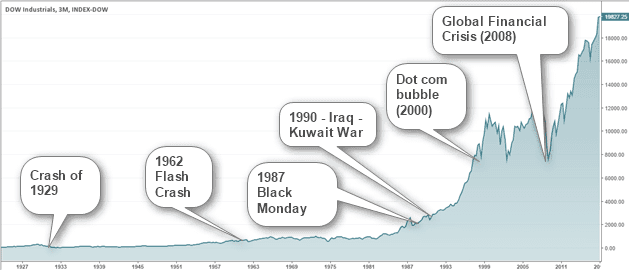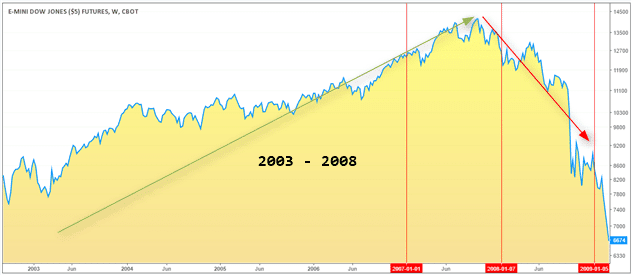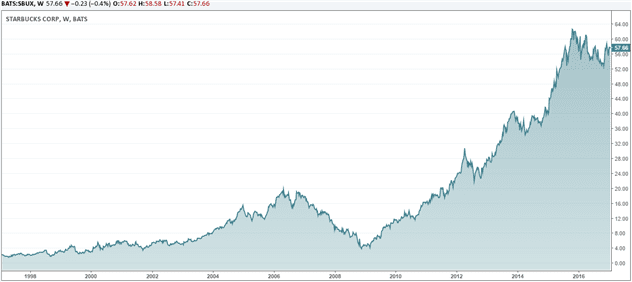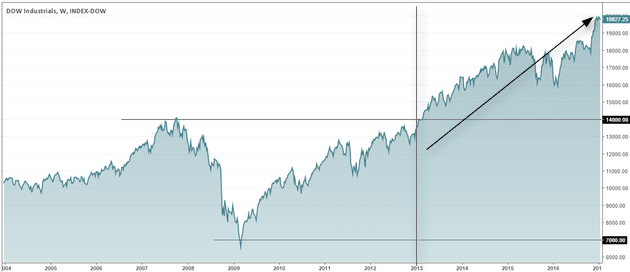September 29th 2008 was the day when the stock market, as represented by the Dow Jones Industrial Average fell 777.68 points during the day, marking the stock market crash. It was the biggest point drop in any single trading day in the history of the Dow Jones.
Stock market crashes, financial bubbles and recessions are nothing new for investors. While these events often come unannounced, they can be disastrous for investors who are not prepared, or those who haven’t taken the time to understand similar events in the past.

Stock Market Crashes Over the Years
The year 2008 started off on a grim note as the BEA announced a 0.6% GDP growth rate for the U.S. in the fourth quarter of 2008. The U.S. economy was weak, shedding 17k jobs for the first time in the past four years. But the Dow Jones shrugged of the news and was seen trading within the levels of 12,000 – 13,000 during the first quarter of the year.
It was in mid-March the Federal Reserve intervened to save Bear Stearns, the investment bank, which was the first casualty of the subprime mortgage crisis. The Dow index fell briefly but managed to recover later in the day as back then the prevailing wisdom was that rescuing Bear Sterns would keep the markets from selling off and avoid a bear market. Over the next months, the Dow Jones rose back to the 13,000 levels by May with many investors believing that the worst was over.
However, the subprime mortgage crisis continued to spread, this time to government sponsored agencies, namely Fannie Mae and Freddie Mac, both of which required a government bailout with the treasury department guaranteeing $25 billion in loans as it purchased the shares of Fannie Mae and Freddie Mac. This was in July and the Dow was seen hovering near the 11k handle by mid-July 2008 and remained trading at this level for the most of summer.
By September 2008, the markets were overwhelmed by the news of Lehman Brothers declaring bankruptcy which set the ball rolling. The Dow fell over 500 points on the news on September 15th and a day later the Federal Reserve announced that it was bailing out AIG, the insurance giant to the tune of $85 billion for 79.9% of equity in effect taking over a controlling ownership in the company. AIG fell prey to the subprime crisis as it fell short of cash to pay off the credit default swaps it issued previously against falling mortgage backed securities. A day later, the money markets lose over $144 billion as investor panic spread pushing yields on the ultra-safe treasury notes lower as a result of increased demand. The Dow index continued to shed another 449 points on the day.
Around September 18 and 19, the Dow posted a modest recovery as the markets learned about a new bank bailout package. The Dow closed the week at 11,388.44 as the Fed established the asset-backed commercial paper money market mutual fund liquidity facility. The Fed loaned over $122.8 billion to banks to buy the commercial paper from the money market funds and by September 21st, the Treasury guaranteed $50 billion worth to nearly frozen money markets.
The following week saw the Treasury secretary Hank Paulson and Fed Chairman, Ben Bernanke send the bank bailout bill to Congress which was rejected on September 29th sending the Dow Jones into a tailspin.
The contagion spread across the globe as equity markets fell sharply while sending safe haven asset highs. Gold for example jumped to $900 an ounce.
In an effort to restore financial stability the Federal Reserve along with other major central banks opened up currency swap lines to the tune of $620 billion with the governments being forced to provide the liquidity for the frozen credit markets.
A month later, Congress passed the bailout bill but by then panic swept across the markets globally. In the U.S. the labor department’s payrolls report showed that the U.S. economy shed 159k jobs during September and on Monday, October 6th the Dow Jones fell another 800 points before closing near 10,000 for the first time in over four years.
Meanwhile the Fed continued to fight the liquidity crisis by lending another $540 billion to meet the barrage of redemptions as businesses started hoarding cash as LIBOR rates jumped. The Federal Reserve coordinated with other central banks as it was forced to lower the short term interest rate to 1%. Despite the attempts, the LIBOR rate remained high at over 3.4%.
Despite repeated attempts, the Dow continued to fall, losing over 13% during the month and by October end, the BEA released more grim news noting that the U.S. economy contracted 0.3% during the third quarter of 2008 and officially called it a recession. Meanwhile the economy continued to lose jobs as in October; the labor department report showed the economy shedding 240k jobs during the month. The U.S. Treasury later announced that it was using part of the $700 billion in bailout to buy preferred stock in the country’s banks which saw the big three automobile makers also coming forward to seek a government bailout.
A month later, the Fed had to cut the short term rates further to zero percent, making it the lowest level of interest rates in its history. By December 2008, the Dow Jones was down 34% for the year.
Seven things, the 2008 market crash has taught us
Lesson #1: Investing is risky
Very often, it is easy to forget the risks involved when it comes to investing especially when major stock indexes break out to new highs. The euphoria that follows such events often blinds investors to the downside in the markets.
In 2008, investors were just recovering from the dot com bubble earlier in the decade. The Dow Jones was posting a steady recovery for nearly five years or so and the benchmark index was bursting into new territory with other indexes also hitting record highs. Investor sentiment at the time was convinced of the bull market and that the stocks would continue to keep rising.
The wave of optimism led to complacency among the investors who were unprepared for the risks. While some seasoned investors might have had contingency plans, at the center of the risk was the average Joe who got sucked into the markets, tempted by the bullish performance in the markets.
Lesson #2: Just because something that didn’t happen in recent times doesn’t mean it won’t
The classic “expect the unexpected” is true for the markets. The biggest lesson that the crash of 2008 taught investors was to take measures to prepare for the worst, because the market reality can be worse that what one might have imagined. That is because when investors are under stress, the markets start to behave irrationally and this become less efficient.
Nassim Taleb popularized the term “black swan” as an event that is rare and hard to predict. While no one knows when it happens, it will happen at some point. Investors, who turn complacent or too greedy end up taking on more risk, thus put their portfolio at the whims of the markets. It also brings to light the well known fact that investors and especially the retail community tend to get bullish right near the top of a stock market rally.

Dow Jones futures, bullish rally since 2003 – 2008
The above chart shows the Dow Jones futures during the periods of 2008 and the years before where the Dow Jones was in a bullish rally. While in hindsight there were clear signs of price topping out, in reality retail investors would have been bullish on the Dow Jones continuing its winning streak a phenomenon quite common just before a big correction or a crash in the stock markets similar to 2008 crisis.
Lesson #3: Take forecasts with a pinch of salt
Prior to the 2008 market crash, Wall Street was optimistic. The prevailing wisdom of that time was that house prices would continue to keep going higher, with no justifiable reason given whatsoever. Even people in prominent positions, like the Treasury Secretary, Hank Paulson were quoted as saying, “We looked at the data since 1945 and we concluded house prices don’t go down.” Likewise other general wisdom was that equity markets produced on average, 9% returns a year. Ask why and the answer simply is because of “historical averages,” or whatever else Wall Street or other prominent names can conjures.
For an investor who simply took the forecasts at face value would have no doubt come face to face with a harsh reality check and perhaps an expensive lesson as well. As retail traders, the Internet and the financial media is often pounded by tons and tons of experts giving advice on what you should do with your money and where to invest. It can get easy for an investor to fall prey to the constant images of these so called experts and their mega returns as the reason behind the nicknames.
In reality, investors should always be prepared for the inevitable. Even if conventional wisdom dictates that stocks will always go up, investors should not for a moment take that for granted.
Lesson #4: The people in charge do not have crystal balls
When the 2008 crisis hit, even the best of the economic minds were taken by surprise. For example, officials at the International Monetary Fund were stunned by the crisis. Even the officials at the U.S. Federal Reserve thought that the blowup of the subprime mortgage crisis would be contained with some if not many economists getting it wrong on the recession.
One of the common themes that we see even now is the general feeling by the market participants that the officials know a lot more than the average investor. This can be seen during the monthly FOMC meetings and especially when there are key policy decisions to be made. Regardless of a rate hike, or a rate cut or even keeping rates steady, the markets and by extension the market participants tend to behave as if the Fed officials know a lot more. If you take a step back at think objectively, you will realize that the members who decide on whether interest rates should rise or fall are merely reacting to the economy, just like everyone else.
Lesson #5: Too Much of a Good Thing
Bubbles are nothing new to the investing community. The 2008 financial crisis saw the subprime mortgage bubble burst which had rather widespread repercussions which snowballed into something bigger than what it initially was.
Bubbles tend to occur all the time in the markets and in reality no one knows about the bubble until it has burst. While there is no scientific or an objective way to identify a bubble or to predict a financial crisis, age old common sense dictates that too much of a good thing can be bad.
Lesson #6: There are always opportunities to invest
Even in midst of the storm, investing opportunities are aplenty for the savvy investor. As the 18th century nobleman Baron Rothschild famously said, “Buy when there’s blood in the street,” sums up the contrarian investing. Usually, stocks hit rock bottom during the financial crisis.
While not all stocks recover strongly, for the trained eye, an investor can pick just the right stocks at a bargain price and thus position themselves for some big returns. Starbucks (SBUX) is one of the many such examples. As the stock bottomed in 2009, many experts felt that with the tough times, people would buy less coffee. Starbucks, which was trading at around $4 a stock has been in a strong bull run since then.

Starbucks stock rally from $4 in 2008 – 2009
Lesson #7: There is life after a market crash
Talk about a market crash and chances are that you will hear about the doom and gloom. However, if history is anything to go by, there is life after a financial crisis or a stock market crash. Every time the markets enter a period of stress, the doomsayers often circle around calling it the next big crash that the markets won’t recover from. It was the same during the 1980’s and even earlier and the 2008 market crash wasn’t different either.

Dow Jones Industrials, recovery after nearly 4 hours from the bottom in 2009
Most investors don’t really get a chance to recover from their losses as then tend to sell their holdings when the markets crash. While stocks definitely don’t recover overnight, history shows that over a period of time, the markets tend to recover and break ground into new highs.
There are many other lessons that one can learn from the stock market crash of 2008 and even the previous market crashes. However, if there was just one lesson to learn, then it is the fact that investing is a very risky business and just because the markets are continuing to rally doesn’t mean that they will continue to rally. Most investors often fall prey to greed and end up not paying attention to risk. It is often said in the investing and trading community that good traders manage risk, bad traders chase profits, and this couldn’t be further from the truth.
For more on business news and information on general market conditions, please visit: Sortiwa.com











 Investment Articles
Investment Articles 
